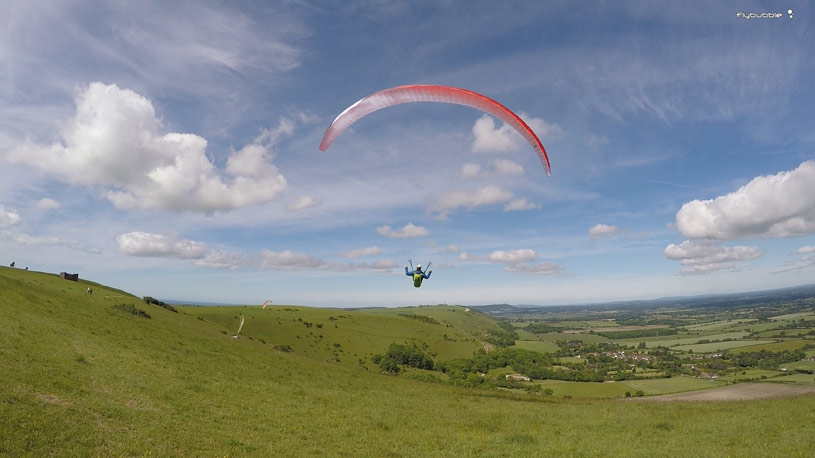
Ridge soaring provides an essential learning environment for low airtime pilots, allowing you to build airtime without the turbulence and hit-and-miss altitude of thermic flying. But after you've gone up and down the ridge twenty times, what else can you do? Are there some things you could be exploring to improve your skills faster? Yes there are!
1. Let the wing pull you uphill

If the wind is straight onto the hill, running uphill will reduce the power. Let your wing pull you rather than fighting it by leaning back, which generates too much power and leads to an explosive launch. If there's a crosswind, to avoid the danger of the wing pulling you downslope, lay out skew so the wing pulls uphill, it's much easier to control. If you like everything you can steady the wing into wind, straight, and then launch (for more about this technique, read Crosswind Launching).
2. Soar the upwind edge of the lift band

When the wind is strong, you don't need to be close in on the slope. Strong wind also means it's more turbulent close to the slope, so it's better to just point into wind, keep riding it until the lift stops.
Once you've established where the edge of the lift band is, you can soar on the outside of that lift band, as far as possible from the Venturi (accelerated wind on top of the ridge). This gives you options: if the wind increases you've got more time to get on speedbar. You can also explore pockets of lift more, because you have more freedom of movement.
3. Learn to manage the energy during turns

When you're ridge soaring, it's a very good time to practice energy management. You want to try and get your turns so you're not wasting energy, this will be very useful when you're thermaling. So when you do a turn, try and make it so that when you come out of the turn there's no second swing-through, controlling that pitch on the brakes so you make it really smooth. So put in a turn, let it swing through and try and control that energy. It's very subtle, but when you get it right you'll feel it's really smooth.
4. Develop your pitch control

You can do the same with pitch control, just coming down on the brakes a bit, letting the glider dive forward, letting it swing through and trying to smoothen the pitch out. Pitch- and turn control are both useful skills to have, and the best time to build them up is when it's smooth and soarable, so there's nothing upsetting your controls.
5. Improve your tight turns

Another thing you can practice is getting tight turns using weight shift first. Use a little bit of weightshift to start the turn, then two seconds later a bit of brake. Your glider wants to flatten out a little bit after the first 180, if you keep your weight in you get a really nice turn, play with that, come out of the turns, back to level smooth, and the whole time you're working on getting your glider control so that the wing is nice and smooth, you don't have these big pitches. It's also quite a lot of fun.
Come around to 360, back to level, and try to lock your heading in. Find a point on the horizon and imagine that you're coming in on rails. Developing this precise control really improves your ability to thermal accurately.
6. improve your brake position

When you're controlling your glider, try and avoid pushing your hands ahead of the risers. This is a common mistake. When you push forward you can start chafing the brake lines against the rear glider lines. You're trying to stabilise your body by pushing away, and pushing yourself back into your harness. I'd suggest try and set your harness up better so you don't feel the need to do that. A much better control position is to pull straight down, in line with the riser.
7. Practice 360 turns (high and ahead)

If you're far enough away from the slope, you can practice just gentle 360 turns, but be very careful of doing this when you're ridge soaring, because you'll really speed up towards the ridge during the downwind turn. So only if you're high and well ahead. But it develops your spatial awareness and ability to judge the wind drift, vital skills for safe flying. Beware of the downwind devil!
8. Use pockets of lift to progress upwind

When it's a bit thermic in soaring conditions, turn into wind. You can follow light lines of lift, upwind, to find the real thermal core. When your climb rate accelerates, turn and use your freshly honed skills to get a steady climb, all the way up!
9. Avoid windy parts of the terrain.

When soaring any kind of bowl, don't fly to the very back of the bowl where the wind is funneled and accelerated. Any thermals that get forced into that area will add to the wind strength, and will be so slanted that you can't use them to climb safely. If you fly out in front of these areas, or along protruding spines, you have a better chance of finding thermals you can use.
10. Have fun!
The pilots who develop fastest are the ones who play with their wings. Mess around on the ground, swoop over the bushes, practice your toplanding approaches, using your speedbar, going up, coming down. The sky is a massive playground, and the more you play in it the more you develop your skill set and expand your safety envelope.
